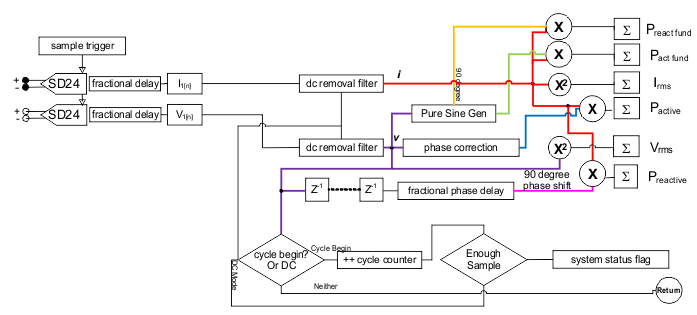SLAA638A august 2014 – may 2023 MSP430I2040 , MSP430I2041
- 1
- Single Phase and DC Embedded Metering (Power Monitor) Using MSP430I2040
- Trademarks
- 1 Introduction
- 2 Design Details
- 3 Calibration Techniques
- 4 Hardware Setup
- 5 Calibrator Software
- 6 Operating the PC Software Tool
-
7 Serial Communication Commands
- 7.1 Introduction
- 7.2 Communication Protocol
- 7.3
Commands
- 7.3.1 HOST_CMD_GET_METER_NAME
- 7.3.2 HOST_CMD_GET_METER_VER
- 7.3.3 HOST_CMD_GET_METER_CONFIGURATION
- 7.3.4 HOST_CMD_GET_RTC
- 7.3.5 HOST_CMD_ALIGN_WITH_CALIBRATION_FACTORS
- 7.3.6 HOST_CMD_SET_PASSWORD
- 7.3.7 HOST_CMD_GET_READINGS_PHASE_N
- 7.3.8 HOST_CMD_GET_EXTRA_READINGS_PHASE_N
- 7.3.9 HOST_CMD_SUMCHECK_MEMORY
- 7.3.10 HOST_CMD_CLEAR_CALIBRATION_DATA
- 7.3.11 HOST_CMD_SET_CALIBRATION_PHASE_N
- 7.3.12 HOST_CMD_GET_CALIBRATION_PHASE_N
- 7.3.13 HOST_CMD_SET_CALIBRATION_EXTRAS
- 7.3.14 HOST_CMD_GET_CALIBRATION_EXTRAS
-
8 Firmware and Embedded Metering Library API
- 8.1 Introduction
- 8.2
Embedded Metering LIbrary API
- 8.2.1
Embedded Metering Library Function Calls
- 8.2.1.1
Functions for Metrology Engine Control
- 8.2.1.1.1 Functions for Metrology Engine Control
- int metrology_init (void)
- int metrology_init_from_nv_data (void)
- void align_metrology_with_calibration_data (void)
- void metrology_switch_to_normal_mode (void)
- void metrology_init_analog_front_end_normal_mode (void)
- void metrology_disable_analog_front_end (void)
- 8.2.1.2 Procedure for Metrology Engine Initialization
- 8.2.1.3
Functions for Calculate and Reading the Readings
- 8.2.1.3.1 Functions for Calculate and Reading the Readings
- power_t calculate_phase_readings (void
- power_t active_power (int ph)
- power_t reactive_power (int ph)
- power_t apparent_power (int ph)
- power_t fundamental_active_power(int ph)
- power_t fundamental_reactive_power(int ph)
- power_factor_t power_factor (int ph)
- rms_voltage_t rms_voltage (int ph)
- rms_voltage_t fundamental_rms_voltage(int ph)
- thd_t voltage_thd(int ph)
- rms_current_t rms_current (int ph)
- rms_current_t fundamental_rms_current(int ph)
- thd_t current_thd(int ph)
- int16_t mains_frequency (int ph)
- uint16_t phase_status (int ph)
- 8.2.1.1
Functions for Metrology Engine Control
- 8.2.2 Embedded Metering LIbrary Callbacks
- 8.2.3
Application Level Calibration Functions
- 8.2.3.1
Functions for Reading and Writing Calibration Parameters
- 8.2.3.1.1 Functions for Reading and Writing Calibration Parameters
- int get_calibration_status (void)
- void set_calibration_status (int value)
- int clear_calibration_data (void)
- int16_t get_temperature_intercept (void)
- int16_t get_temperature_slope (void)
- void set_temperature_parameters (int16_t temperature_at_calibration, int16_t temperature_sensor_intercept, int16_t temperature_sensor_slope)
- calibration_scaling_factor_t get_P_scaling (int phx)
- void set_P_scaling (int phx, calibration_scaling_factor_t value)
- calibration_scaling_factor_t get_V_rms_scaling (int phx)
- void set_V_rms_scaling (int phx, calibration_scaling_factor_t value)
- int16_t get_v_dc_estimate (int phx)
- int16_t get_initial_v_dc_estimate (int phx)
- void set_v_dc_estimate (int phx, int16_t value)
- int32_t get_v_ac_offset (int phx)
- void set_v_ac_offset (int phx, int32_t value)
- calibration_scaling_factor_t get_I_rms_scaling(int phx);
- void set_I_rms_scaling(int phx, calibration_scaling_factor_t value);
- int32_t get_i_dc_estimate(int phx);
- int32_t get_initial_i_dc_estimate(int phx)
- void set_i_dc_estimate(int phx, int32_t value);
- int32_t get_i_ac_estimate(int phx);
- void set_i_ac_offset (int phx, int32_t value)
- uint16_t get_compensate_capacitor_value (int phx)
- void set_compensate_capacitor_value (int phx, uint16_t value)
- uint16_t get_compensate_resistance (int phx)
- void set_compensate_resistance (int phx, uint16_t value)
- int16_t get_phase_corr (int phx)
- void set_phase_corr (int phx, int16_t value)
- 8.2.3.1
Functions for Reading and Writing Calibration Parameters
- 8.2.4 Setting Default Calibration Parameters
- 8.2.1
Embedded Metering Library Function Calls
- 9 Example Application Code
- 10Hardware Design Files
- 11EVM Specification and Performance
- 12Running on MSP430i2040 and MSP430i2041
- 13Revision History
2.3.3 Background Process
In the background, time-critical sample-based process is performed. The flow of the background processing is straight forward, the process started at the sample rate by a trigger of sampling complete interrupt. The background process then:
- Capture data from voltage and current ADC channels
- Perform voltage sample processing
- Current sample processing
- Power processing
- Line frequency processing
- Trigger foreground process
Figure 2-5 shows the system functional diagram, the two SD24 ADCs take samples from the voltage and the current channel with the (calibrated and programmed) fractional delay. The samples are then passed through a DC removal filter. Each DC removal filter dynamically tracks the DC offset of the ADC and the signal by analyzing each sample and removes the DC (from signal and from ADC DC offset) before passing the sample to further processing. If the operation is in DC mode, the DC removal filter only removes the DC offset of the ADC.
The current sample and the voltage sample then performs a square and accumulates to get the root mean square current (Irms) and voltage (Vrms). The current sample also multiplies and accumulates with the voltage sample with proper additional phase delay (if needed) to get the active power (Pactive) and with the corresponding 90° shifted sample to get the reactive power (Preactive).
An internally generated pure sine wave amplitude and phase synchronized with the AC voltage input together with the 90° shifted version are used to multiply and accumulate with the current sample to get the fundamental active and fundamental reactive power.
The cycle detection mechanism detects the presence of an AC signal by checking the number of zero crossing over a pre-defined time. If the number of zero crossing is less than the expected number of zero crossing minus 1, then it is determined to be DC mode otherwise it is in AC mode. This works well for the frequency from 25Hz when the pre-defined determination interval is set to 80 ms.
After 4 AC cycles (or 80 ms in DC mode), the system sets a flag showing that there are results that are needed to be processed. The system is then triggered by this flag to perform the scaling and convert those accumulated values into values of proper units (V, A, W, and so forth).
 Figure 2-5 System Functional Diagram
Figure 2-5 System Functional Diagram